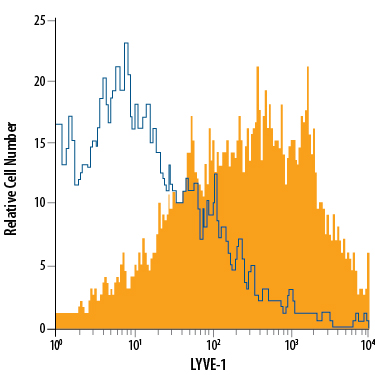Mouse LYVE-1 PE-conjugated Antibody Summary
Ala24-Thr234
Accession # Q8BHC0
Applications
Please Note: Optimal dilutions should be determined by each laboratory for each application. General Protocols are available in the Technical Information section on our website.
Scientific Data
 View Larger
View Larger
Detection of LYVE‑1 in bEnd.3 Mouse Cell Line by Flow Cytometry. bEnd.3 mouse endothelioma cell line was stained with Rat Anti-Mouse LYVE-1 PE-conjugated Monoclonal Antibody (Catalog # FAB2125P, filled histogram) or isotype control antibody (Catalog # IC006P, open histogram). View our protocol for Staining Membrane-associated Proteins.
Reconstitution Calculator
Preparation and Storage
- 12 months from date of receipt, 2 to 8 °C as supplied.
Background: LYVE-1
Lymphatic vessel endothelial hyaluronan (HA) receptor-1 (LYVE-1) is a recently identified receptor of HA, a linear high molecular weight polymer composed of alternating units of D-glucuronic acid and N-acetyl-D-glucosamine. HA is found in the extracellular matrix of most animal tissues and in body fluids. It modulates cell behavior and functions during tissue remodeling, development, homeostasis, and disease (1). The turnover of HA (several grams/day in humans) occurs primarily in the lymphatics and liver, the two major clearance systems that catabolize approximately 85% and 15% of HA, respectively (1-3). LYVE-1 shares 41% homology with the other known HA receptor, CD44 (4). The homology between the two proteins increases to 61% within the HA binding domain. The HA binding domain, known as the link module, is a common structural motif found in other HA binding proteins such as link protein, aggrecan and versican (1, 5). Human and mouse LYVE-1 share 69% amino acid sequence identity.
LYVE-1 is primarily expressed on both the luminal and abluminal surfaces of lymphatic vessels (4, 5). In addition, LYVE-1 is also present in normal hepatic blood sinusoidal endothelial cells (6). LYVE-1 mediates the endocytosis of HA and may transport HA from tissue to lymph by transcytosis, delivering HA to lymphatic capillaries for removal and degradation in the regional lymph nodes (5, 7, 8). Because of its restricted expression patterns, LYVE-1, along with other lymphatic proteins such as VEGF R3, podoplanin and the homeobox protein propero-related (Prox-1), constitute a set of markers useful for distinguishing between lymphatic and blood microvasculature (4, 5, 9-11).
- Knudson, C.B. and W. Knudson (1993) FASEB J. 7:1233.
- Evered, D. and J. Whelan (1989) Ciba Found. Symp. 143:1.
- Laurent, T.C. and J.R.F. Fraser (1992) FASEB J. 6:2397.
- Banerji, S. et al. (1999) J. Cell Biol. 144:789.
- Prevo, R. et al. (2001) J. Biol. Chem. 276:19420.
- Carreira, C.M. et al. (2001) Cancer Research 61:8079.
- Jackson, D.J. et al. (2001) Trends Immunol. 22:317.
- Zhou, B. et al. (2000) J. Biol. Chem. 275:37733.
- Achen, M. et al. (1998) Proc. Natl. Acad. Sci. USA 95:548.
- Breiteneder-Gellef, S. et al. (1999) Am. J. Pathol. 154:385.
- Wiggle, J.T. and G. Oliver (1999) Cell 98:769.
Product Datasheets
Citations for Mouse LYVE-1 PE-conjugated Antibody
R&D Systems personnel manually curate a database that contains references using R&D Systems products. The data collected includes not only links to publications in PubMed, but also provides information about sample types, species, and experimental conditions.
6
Citations: Showing 1 - 6
Filter your results:
Filter by:
-
A Prox1 enhancer represses haematopoiesis in the lymphatic vasculature
Authors: J Kazenwadel, P Venugopal, A Oszmiana, J Toubia, L Arriola-Ma, V Panara, SG Piltz, C Brown, W Ma, AW Schreiber, K Koltowska, S Taoudi, PQ Thomas, HS Scott, NL Harvey
Nature, 2023-01-25;614(7947):343-348.
Species: Mouse
Sample Types: Whole Tissue
Applications: IHC -
Adipose tissue-derived microvascular fragments promote lymphangiogenesis in a murine lymphedema model
Authors: FS Frueh, L Gassert, C Scheuer, A Müller, P Fries, AS Boewe, E Ampofo, CE Rübe, MD Menger, MW Laschke
Journal of tissue engineering, 2022-07-26;13(0):2041731422110.
Species: Mouse
Sample Types: Tissue Homogenates
Applications: Flow Cytometry -
Nucleoside-modified VEGFC mRNA induces organ-specific lymphatic growth and reverses experimental lymphedema
Authors: D Sz?ke, G Kovács, É Kemecsei, L Bálint, K Szoták-Ajt, P Aradi, A Styevkóné, BL Mui, YK Tam, TD Madden, K Karikó, RP Kataru, MJ Hope, D Weissman, BJ Mehrara, N Pardi, Z Jakus
Nature Communications, 2021-06-08;12(1):3460.
Species: Mouse
Sample Types: Tissue Homogenates
Applications: Flow Cytometry -
Lymphangiogenesis in kidney and lymph node mediates renal inflammation and fibrosis
Authors: G Pei, Y Yao, Q Yang, M Wang, Y Wang, J Wu, P Wang, Y Li, F Zhu, J Yang, Y Zhang, W Yang, X Deng, Z Zhao, H Zhu, S Ge, M Han, R Zeng, G Xu
Sci Adv, 2019-06-26;5(6):eaaw5075.
Species: Mouse
Sample Types: Tissue Lysates
Applications: Flow Cytometry -
Apelin modulates pathological remodeling of lymphatic endothelium after myocardial infarction
Authors: F Tatin, E Renaud-Gab, AC Godet, F Hantelys, F Pujol, F Morfoisse, D Calise, F Viars, P Valet, B Masri, AC Prats, B Garmy-Susi
JCI Insight, 2017-06-15;2(12):.
Species: Mouse
Sample Types: Tissue Homogenates
Applications: Flow Cytometry -
Gene-expression profiling of different arms of lymphatic vasculature identifies candidates for manipulation of cell traffic
Proc Natl Acad Sci USA, 2016-09-06;113(38):10643-10648.
Species: Mouse
Sample Types: Whole Cells
Applications: Flow Cytometry
FAQs
No product specific FAQs exist for this product, however you may
View all Antibody FAQsReviews for Mouse LYVE-1 PE-conjugated Antibody
There are currently no reviews for this product. Be the first to review Mouse LYVE-1 PE-conjugated Antibody and earn rewards!
Have you used Mouse LYVE-1 PE-conjugated Antibody?
Submit a review and receive an Amazon gift card.
$25/€18/£15/$25CAN/¥75 Yuan/¥2500 Yen for a review with an image
$10/€7/£6/$10 CAD/¥70 Yuan/¥1110 Yen for a review without an image

